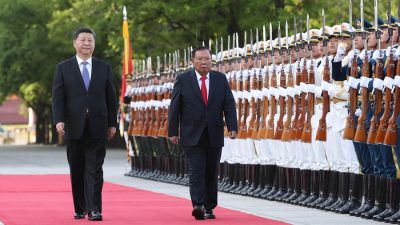China-Laos Economic Relations. The Broader Strategic Implications

The Chinese and Laotian Presidents signed an action plan to build a community of shared future earlier this week after the latter’s trip to the People’s Republic to attend the recent BRI Forum. These two nations might seem to be an odd pair to the unaware observer who would instantly notice the obvious asymmetries in their geographic and demographic sizes, but these two countries actually share very close and fraternal relations with one another that are destined to strengthen following the completion of the China-Laos railway by the end of this year, therefore making the agreement that their two leaders just signed all the more relevant in the forthcoming strategic context. The aforementioned project isn’t a stand-alone one but is part of the larger Kunming-to-Singapore high-speed railway vision that forms the regional basis of China’s BRI investments in ASEAN, and the key to the success of this “ASEAN Silk Road” is none other than Laos.
Despite being tiny, Laos boasts an outsized geostrategic importance because it’s adjacent to all of the states in the Greater Mekong Subregion (mainland ASEAN), which is why its decision makers consider it to be “land-linked” instead of just landlocked. Furthermore, the country is investing heavily in dams along the Mekong River in order to become the “battery of Southeast Asia” through its planned export of hydroelectricity throughout the energy-hungry region. Both of these interconnected visions perfectly complement China’s integrational ones through the Belt & Road Initiative (BRI), therefore making it the perfect partner for the People’s Republic to pair up with. Additionally, Laos is also a communist country just like China, which is yet another convergence of interests that these two neighbors share. In fact, its governing model and small population make it more likely that Laos will be able to fairly disperse the land-linked, hydroelectrical, and Silk Road wealth that it expects to earn in the coming future.
This is a very important point because Laos is still struggling to recover from the devastation of the Vietnam War-era when the US dropped more bombs on it than during the entirety of World War II, an infamous but little-known fact that former President Obama even apologized for during his historic 2016 visit to the country. Without Chinese support, Laos would have difficulty developing and bringing its people into the 21st century. The country’s geography is highly varied and very tough to traverse in some regions, though the ASEAN Silk Road will change all of that because of the many tunnels and bridges that are being built along its route, which are engineering marvels in their own right and will greatly contribute to connecting Laos’ people to the rest of the region and the world at large, especially by means of its Chinese and Thai neighbors.
The example being set by Chinese-Laotian relations is that win-win cooperation can still prevail regardless of the size asymmetries between states. China has an interest in developing Laos’ connectivity potential and helping it achieve its goal of becoming the land-linked core of the Greater Mekong Subregion because this provides the People’s Republic with reliable overland access to Thailand, which has the largest economy in mainland ASEAN. Laos, meanwhile, benefits from the billions of dollars’ worth of infrastructure projects that China is funding and can turn the ASEAN Silk Road into the country’s primary developmental corridor by taking advantage of its irreplaceable role facilitating Chinese-Thai trade. As a result, both China and Laos can reap the benefits of their bilateral cooperation in spite of the glaring differences in their geographic and population sizes, proving that BRI is the ultimate equalizer between states and pioneering a new model of International Relations.
*
Note to readers: please click the share buttons below. Forward this article to your email lists. Crosspost on your blog site, internet forums. etc.
This article was originally published on Oriental Review.
Andrew Korybko is an American Moscow-based political analyst specializing in the relationship between the US strategy in Afro-Eurasia, China’s One Belt One Road global vision of New Silk Road connectivity, and Hybrid Warfare. He is a frequent contributor to Global Research.
Featured image: Chinese President Xi Jinping and Lao President Bounnhang Vorachit (Source: Oriental Review)

